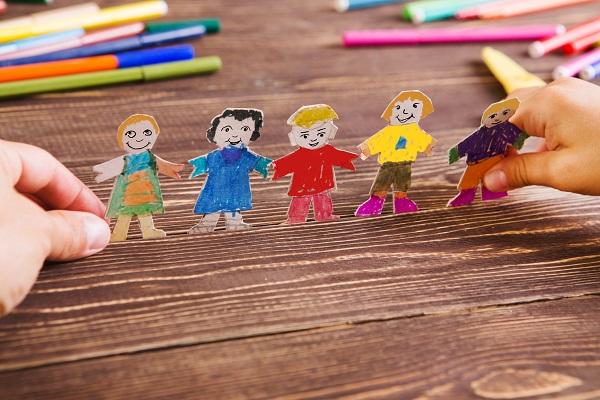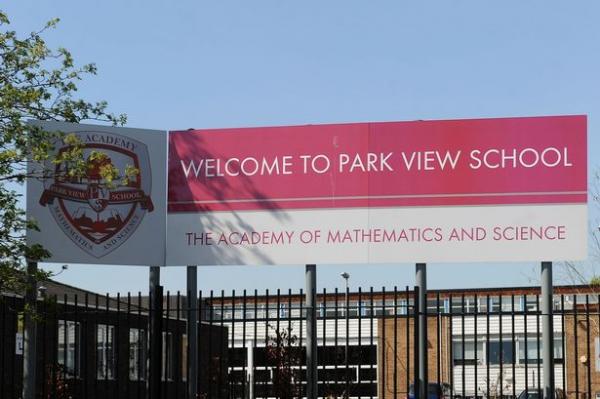what does it means to be part of a school community
The transformative power of school-community relationships is plain to see. Karamat Iqbal explains what schools can proceeds from strengthening their local ties.

If nosotros look closely enough at our communities, nosotros discover that many of them are rich in dissimilar types of capital and assets which, when properly utilised, can add significant value to the core business organization of schools.
Now and then policymakers volition recognise this potential, admitting fleetingly, earlier they go back to yet more of the same concentration on 'in-school' practices. Many of usa remember the 2004 National Standards for Headteachers, which made articulate that 'schools be in a distinctive social context, which has a straight bear upon on what happens within the schoolhouse.'
Headteachers were advised to commit to engaging with their external community in society to piece of work collaboratively with parents and others.
This was an era of Schools Plus, when the then-government minister for school standards, Estelle Morris, had spoken of 'community in the school and the school in the customs' – with both willing to and being comfy working in the other's space.
Why carp!
Of course, schools volition want to know what they are to proceeds from developing community links.
Information technology is well recognised that when parents are involved in their child'southward education, that child does better on a range of measures. They deport better, nourish schoolhouse more often, are at lower take a chance of exclusion, are keener to learn and achieve better results.
Potent links with the customs can make a particular contribution to the piece of work of schools serving disadvantaged communities. They have been shown to help raise educational standards and close the achievement gap between rich and poor children. In such contexts schools are ofttimes keen to raise aspirations of their children and parents, which tin can piece of work when you take a 'neighbourhood' arroyo.
It is therefore necessary to mobilise schools' external communities in order to engender positive attitudes towards education.
Another surface area where the wider customs can be a useful asset is in the provision of extracurricular learning, which tin can make a real difference to raising educational standards. Such activities demand not be provided within the schoolhouse and by teachers alone. Individuals and organisations inside the wider community can be a valuable resources for learning.
To see the difference a strategic level partnership between community and local authority tin can make, await no further than Tower Hamlets. The turning point was in 1998, when a damning Ofsted report drew attention to the fact that but 26 per cent of pupils in the borough gained 5 or more A–C grades at GCSE, compared with a national average of 43 per cent. But over a x-yr catamenia, this changed dramatically. By 2011, 61.4 per cent of Tower Hamlets pupils achieved five or more A*–C grades at GCSE, exceeding the national average for the get-go time.
Partnership with the local community played an important role on this journeying of transformation. The council and schools worked closely with customs organisations. A number of the schools became informal community centres, providing resources and recreation for children, young people and adults.
This resulted in:
- children having an average of 90% or to a higher place omnipresence
- parents having positive attitudes to local schools
- uncommonly high omnipresence at all parents' meetings.
Having a good for you and respectful relationship with its customs tin benefit a school in its recruitment of local people as teachers and a range of other roles, equally was the example in Tower Hamlets. These local practitioners:
- take a unique agreement of the school's relationship to the neighbourhood and can act equally a span
- enter classrooms every bit constitutents of the customs, with a particular noesis of the schoolhouse'due south context
- know parents, businesses and customs organisations
- have an established network of local relationships, which can exist valuable for the schoolhouse.

Landscape art on Brick Lane, Tower Hamlets. 'Partnership with the local community played an important role on this journey of transformation'
Possible responses
Community links and partnerships do not flourish overnight. They take time that busy schoolhouse leaders and staff cannot spare.
Nonetheless, the long-term benefits can make the investment worthwhile. Central to such a relationship is education practitioners' understanding of the wider customs. For the same Schools Plus policy to succeed, it was important that they felt comfortable in working in the 'space' inhabited past the parents of their children and others in the wider community.
In a report from the National College of Schoolhouse Leadership, this understanding was referred to as 'contextual intelligence'. The leaders with such understanding were found to be sensitive to their school's external environment without beingness patronising or condescending. They tended to talk most the strengths of the local customs rather than its weaknesses; the locality equally an opportunity rather than a trouble.
Research has reinforced the importance of schoolhouse leaders connecting with the community. Participants in i written report were constitute to exist acutely aware of the need to engage with their community.
'They visited homes, attended community events, communicated regularly with the parents most successes and engendered trust by showing 18-carat intendance for young people.' Furthermore, 'they understood the forces within the customs that impeded learning, they were aware of the negative forces of the sub-cultures and they listened to parents' views and opinions regularly.'
The leaders concerned were in a position to recognise that 'family, school and community relationships directly affected student outcomes hence the demand to connect with the community was of paramount importance to the success of the school.'
The Headteacher Standards referred to above had pointed out that 'schoolhouse improvement and community development are interdependent.' Community development can assist the stakeholders to recognise and develop their power and potential and organise themselves to respond to their common issues and needs.
'Information technology supports the establishment of potent communities that control and use assets to promote social justice and help improve the quality of community life. It also enables community and public agencies to piece of work together to better the quality of authorities.
All communities take assets, skills and resources but they also have constraints that limit what is possible
A related term is community capacity building. Some communities, especially those who endure from economic and social disadvantages, oftentimes need a helping manus to enhance their capacity to brand a departure. Such an approach starts with a viewpoint that 'all communities take assets, skills and resources but they also accept constraints that limit what is possible'.
It is suggested here that schools tin can learn from the community organising tradition championed by Saul Alinsky: 'The first matter you've got to do in a community is listen, not talk and learn to consume, sleep, breathe simply one matter: the problems and aspirations of the community.' Similarly, Paulo Freire had brash that people wishing to piece of work together needed to enter each other's worlds.
Such an arroyo tin assistance schools accept a different perspective in disadvantaged contexts. Rather than referring to parents who do not nourish meetings when invited equally 'hard to reach', schools tin can come to a realisation that it is they who are the possible cause of such exclusion.
In a similar vein, Debra Kidd has recommended that schools help engender pride amid their children in relation to the communities they vest to:
'Discover the local heroes, the people running charities and food banks for example. Bring them into school to talk most what they are doing to make the community a improve place. […] Give children a sense of moral purpose that is linked to where they live.'
Read Debra'due south full interview with Elizabeth Holmes, 'Education is for everyone', for more on social mobility, disadvantage and the office of the community.
Losing local
Where walls and fences come up into existence betwixt schools and their communities the cost can be massive. This was discovered in Birmingham through the Trojan Horse matter. Iii years prior to the controversy, Tim Boyes, current Head of the Birmingham Pedagogy Partnership, had made a presentation to the Department for Education.
He had pointed out a number of 'vulnerabilities' in the local authority. I of these was a school-customs disconnect. Sadly little was done in response.
Then in 2013 there was an almighty blow-out that has acquired irreparable harm to educational activity locally, particularly to the trust between schools and their communities. When I interviewed Boyes recently, he agreed that a repeat of Trojan Equus caballus was likely.
We have a two-dimensional solution being implemented in response to a three-dimensional problem
Interestingly, Tahir Alam, chair of the Park View Educational Trust, one of the schools at the centre of the affair, has too spoken of poor school-community relations being central to Trojan Horse. In an interview with me he stated that community was the missing link in Birmingham education: 'We have a ii-dimensional solution being implemented in response to a three-dimensional problem.'
The 3rd dimension is the mainly Muslim customs, whose children have been the largest student religious group since 2011, but is generally kept outside the school portals. We are yet to come across schools fully engage with them and benefit from their resource capital. The issue continues to exist low levels of trust betwixt schools and the communities they serve and big numbers of children continuing to leave school without achieving the benchmark qualifications.
Will Ryan, one of the contributors to the first-class Working Class (Gilbert, 2018) asks: to what extent can schools play a role in rebuilding, recreating or, indeed, establishing a sense of community? He then implies that there is little hazard of this happening in the current times where customs schools take been replaced by academy chains run from 'the other side of the country by someone at a desk with a spreadsheet and a knighthood'.
In this Ryan agrees with Boyes, who had expressed to me his view that the 'local' had been lost from community. The notion of school every bit customs-endemic, community-led and belonging in a locality had been undermined past academisation, 'where in that location are arrogant, narrow, express technicians sitting now in some headteacher seats who know how to get skilful results only have got a very limited sociological understanding of their school and its locality and its communities' (Iqbal, 2018).

Tahir Alam, chair of the Park View Educational Trust, has spoken of poor schoolhouse-community relations existence central to the Trojan Horse affair
Bridges, not fences
We are well aware that children spend no more than than twenty per cent of their time at schoolhouse; the residual is spent elsewhere. Many decades of research, especially that on schoolhouse effectiveness, has told united states that schools' capacity to brand a deviation is limited by external factors. This clearly points to a need for new ways to bridge pupils' lives lived in different spheres: habitation, school and the wider community.
If nosotros don't make those connections, schools' island mentality is going to keep equally it has done before, with big numbers of children leaving compulsory teaching every bit failures. This is a particular issue for schools serving disadvantaged communities.
In our work with such schools, we advise them to consider the following questions.
- What does community mean to you lot?
- What resources are there in your schoolhouse community you could tap into?
- What are yous doing already?
- What new partnerships could you build?
- What can you do to build the capacity of your local community?
References
Gilbert, I. (2018),The Working Class(Carmarthen: Independent Thinking).
Iqbal, K. (2018),British Pakistani Boys, Education and the Function of Faith – In the Land of the Trojan Horse(London: Routledge).
More from Optimus
Disadvantage: looking beyond the pupil premium
Education is for everyone
Source: https://blog.optimus-education.com/community-school-and-school-community
0 Response to "what does it means to be part of a school community"
Post a Comment